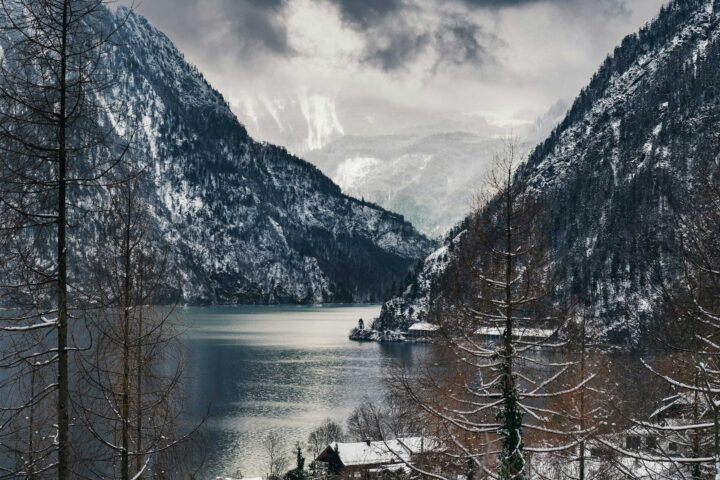I’ve always loved being outside, immersed in nature (I get itchy feet when I’m in indoors for any length of time!) so when I moved to Switzerland from the UK in my early twenties I was immediately drawn away from the city of Geneva, where I lived, to the nearby mountains and spent most of my weekends exploring. I found the mountain environment strikingly beautiful but also so raw and wild—particularly in the winter. When the snow starts falling and totally transforms the landscape, you get a real sense of the power of nature and its inherent dangers, and I began thinking that the mountains would be the perfect backdrop for a chilling thriller.
The idea of setting the novel in a converted sanatorium came about when I was at our holiday home in Crans Montana, a small alpine town a few hours from Geneva, and read a fascinating article in a local magazine about the history of tuberculosis sanatoria in the town. The article opened my eyes to something I didn’t know much about before: how Crans Montana was chosen as an ideal location for sanatoria as doctors believed that the fresh, clean air at altitude and the long hours of sunshine helped tuberculosis patients to rehabilitate. The article described how these sanatoria were the main driver of people coming in numbers to the town, but when antibiotics became available in the mid-twentieth century, some were converted into hotels.
I started thinking about the darker, more sinister side of this—how would it feel to stay in a hotel that had once been a hospital, a place where many people lived and died? I was also drawn to the fact that sanatoriums were often based in remote locations to stop the spread of infection. I realized that this isolated setting could be a great way of putting my characters, especially Elin Warner, the British detective in the novel, under pressure, and how this isolation within the external landscape might mirror Elin’s internal isolation after being on an extended career break. This sense of absolute isolation in the novel only intensifies when heavy snow and an avalanche cuts off all routes to escape from the hotel. With no Swiss police able to get to the hotel, it’s up to Elin and Elin alone to crack the case…
“I’ve always been fascinated by the idea that an old building holds such a history—not just one story, but many.”
With the seed of the idea firmly planted in my mind, I then read Une histoire culturelle de Crans-Montana by Sylvie Doriot Galofaro and liaised with a local photo historian, as well as looked at archive material about sanatoria online. The more I researched, the more I became convinced that an old sanatorium converted into a luxury hotel would be the perfect creepy, gothic setting for a thriller. I’ve always been fascinated by the idea that an old building holds such a history—not just one story, but many. I became excited by the idea of making the building itself a character within the novel in its own right, and that the malevolent energy of the sanatorium might still be lingering despite its conversion into a modern hotel.
I discovered that sanatoria were often designed according to the principles of
“functionalism”—the design and decor themselves optimized to stop the spread of infection and help tuberculosis patients recover (so the building itself became a kind of medical instrument). The design of these buildings became so influential that early 20th century Modernist architects picked up some of the minimalist design of sanatoria (large windows, balconies to maximize exposure to sunlight, clean, smooth surfaces without clutter, floors and walls clear), so there were fewer places for germs to hide.
I began thinking about how this minimalist, clinical design might be used in the conversion into a hotel and how it would be viewed by a guest (and reader!) especially if some eerie reminders of the building’s clinical past were incorporated into the design. I amassed a lot of research on the design and created several mood boards on Instagram and in my scrapbooks about how I wanted the interior to look. I also had some real-life inspiration: there’s a repurposed hotel in Crans Montana called Hotel Chetzeron which sits at nearly 7,000 feet. This hotel, like Le Sommet, has had a previous life, but as a cable car station so high in the mountain that during the winter, guests are often only able to reach it by skidoo. I love how Hotel Chetzeron has used the features of the old building in the new design; in particular, the vast glass window at the front of the hotel was where the cable cars entered and exited the station. The overall look and feel of Hotel Chetzeron is contemporary, as is the hotel in my novel, featuring lots of glass and a beautiful outdoor pool, but without the sinister design features of Le Sommet…
My research into sanatoria also led me in another interesting direction when I discovered that there were sanatoria in Switzerland (and elsewhere in Europe) for people classed as “morally insane.” In the nineteenth and early twentieth centuries, many women were placed in medical care for spurious reasons by a male guardian, often diagnosed with something loosely described as “Nervenkranke” (those ill in their nerves). Sometimes this was trickery, a guise to take control of an inheritance, or to suppress independent thought and ideas. Women could spend decades being “treated.” In one book I read, there are actual copies of letters from both guardian and also the “patient” detailing the lies involved in admitting them to the sanatorium. This research gave me the idea to explore this theme within the novel and the present-day echoes where women are still being judged for their emotions and experiences, which often results in them supressing their feelings in both their personal and professional lives.
This is very much the case with my main character, Elin. She’s a strong woman, but troubled by both a past case that haunts her and a family tragedy. Her swirling emotions around these events mean she’s constantly being judged by the people around her, but she breaks the mold by refusing to do what’s expected and that’s what I love about her. I really wanted her to be a female detective who doesn’t have it all together, someone who has the same fears and anxieties as people do in real life and isn’t afraid to listen to and show her emotions.
Elin goes on such a journey throughout the book, and all of my research really built into the creation of this journey. I wanted to write a novel that was a chilling thriller but also about a woman who has to face down her past and embrace her fears and anxieties in order to survive and progress—something I think we all struggle with in our own way and during our own journeys through life.



